Continued from the last entry . . .
Our fifth stop in Anchorage today was at a
beautiful free museum featuring Native Alaskan art and
culture in the Wells Fargo building at 301 W. Northern Lights Blvd. (at
C Ave.). It is called the
Alaska Heritage Museum.
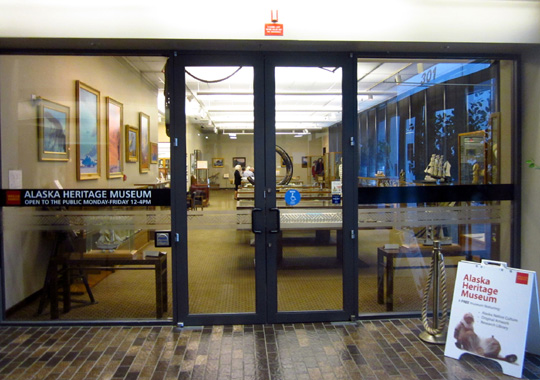
The entrance to the museum is in the lobby of the
Wells Fargo building.
We were impressed by
the scope and beauty of the displays of over 900 works of art and Alaska
Native cultural objects, from traditional to the contemporary.
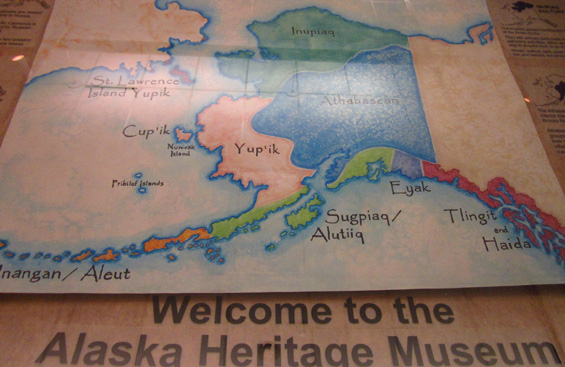
Map showing where the different Native Alaskan
groups live
Included are
-
a display of fine art,
-
traditional clothing from several of Alaska’s dozen or more indigenous
cultural groups,
-
prehistoric artifacts,
-
specialized tools for hunting and gathering,
-
an extensive basket collection,
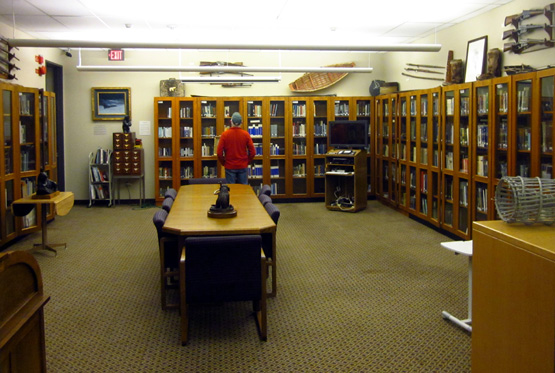
Jim browses in the museum's library.
-
beadwork, clothing and accessories,
-
dolls,
-
an authentic Bearing Sea kayak made of seal skins,
-
many other art and cultural objects,
-
and a library that includes more than 3,600 volumes on Alaskan history.
The next two photos show some of the numerous large display cases:
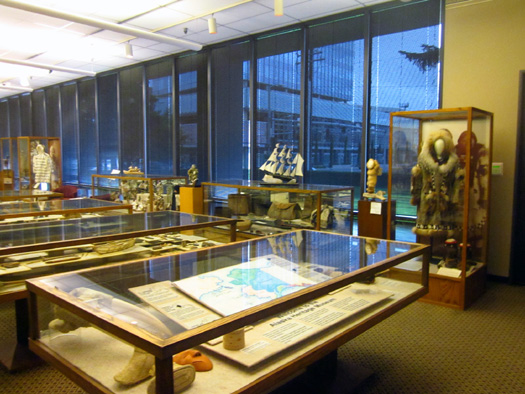
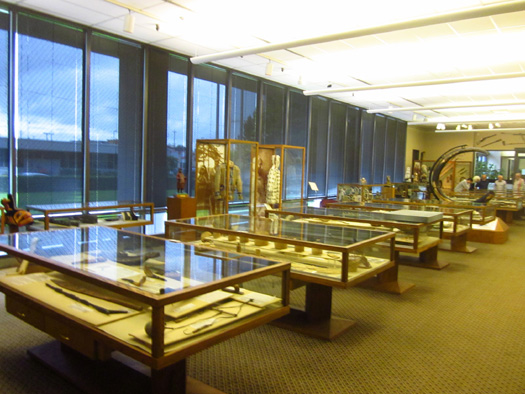
FROM THE ICE AGE TO MORE MODERN HISTORY
The literal "centerpiece" of the museum is this 14-foot wooly mammoth
tusk that was discovered near Fairbanks in 1992:
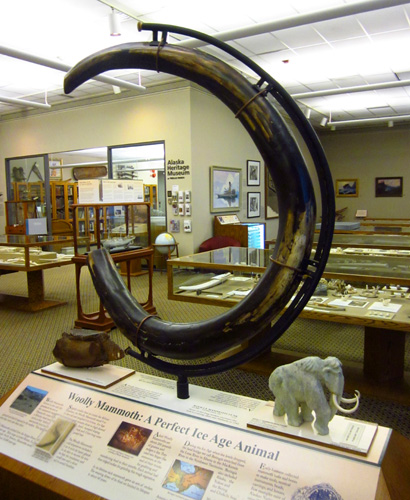
Scientists have determined the tusk is between 12,000 to 15,000 years
old. I enjoyed reading the history of these prehistoric animals.
Briefly, during the last Ice Age sea levels dropped and a land bridge
called Berengia connected Siberia with Alaska, allowing wooly mammoths,
Yukon horses, American camels, saber-tooth tigers, and short-faced bears
to cross into North America.
Early humans, including Native Alaskans (who also crossed Berengia),
used mammoth tusks and bones to make tools, houses, musical instruments,
beads, and carvings.
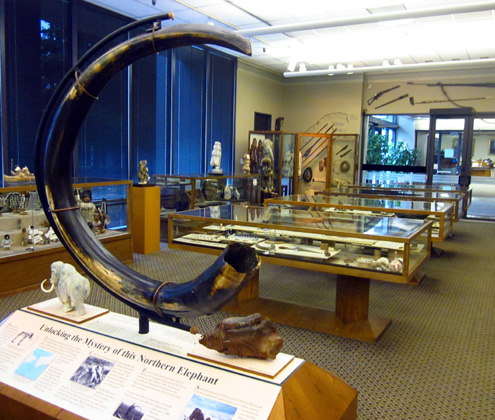
The original mammoths went extinct about 10,000 years ago at the end of
the Ice Age (you think we have global warming now??). Because of
its cold climate, however, dwarf wooly mammoths continued to live in
parts of Alaska until as recently as 3,700 years ago.
The mammoth display also describes modern scientific projects using
sequenced DNA from prehistoric wooly mammoths unearthed from permafrost.
It's all very interesting.
Here are some of the photos I took as we wandered through the museum.
All of the objects are beautifully displayed. My photos don't always do
them justice:
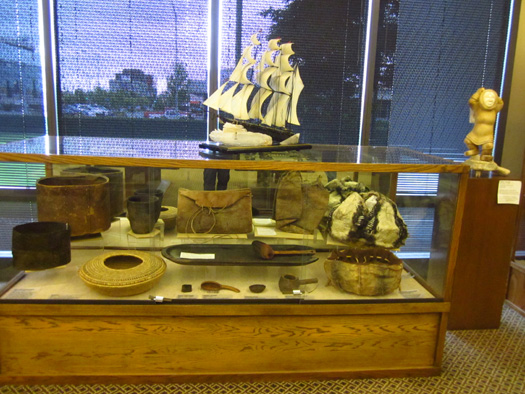
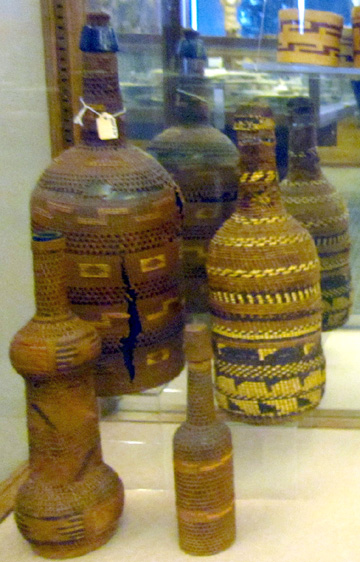
Quite a few woven baskets and covered bottles are
displayed.
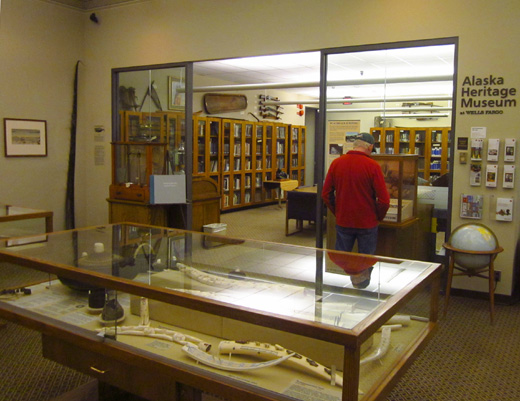
This case holds intricately carved ivory pieces
(some details in next two photos)
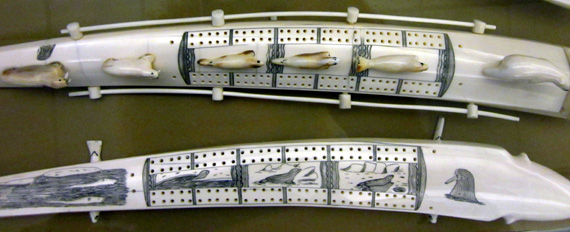
Cribbage?
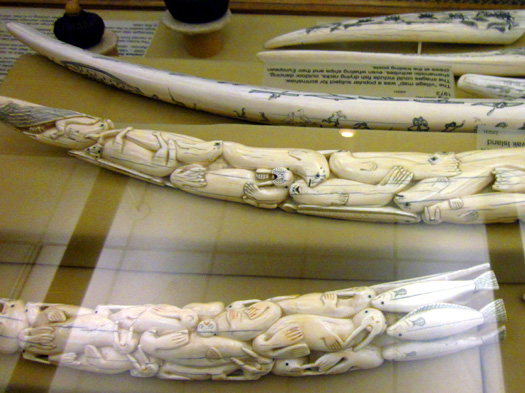
Just look at those tiny carved seals, walruses, and
fish!
THE IMPORTANCE OF KAYAKS IN NATIVE HISTORY
One of the photos on the museum's website this summer shows a better
picture of this Yup'ik or Cup'ig kayak used in the Bering Sea:
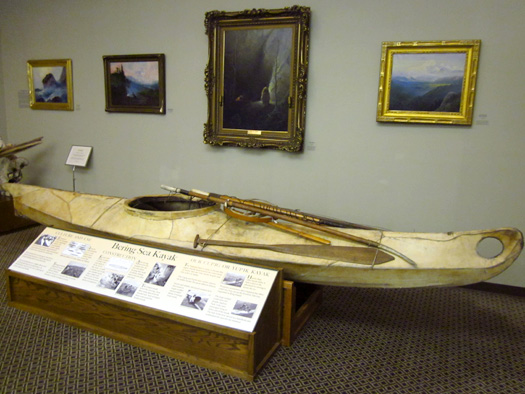
Also note the paintings hanging on the
wall.
This kayak is shorter and heavier than many used by Native Alaskans. It
is built of driftwood and sealskin and large enough to hold two people
and carry a sled to make it easier to transport across ice.
In use for approximately 4,000 years, kayak styles varied widely across
the different cultures of Arctic Alaska. Though gradually replaced
by motorized boats, kayaks were still in limited use in the 1970s. Their
current revival is a symbol of cultural survival.
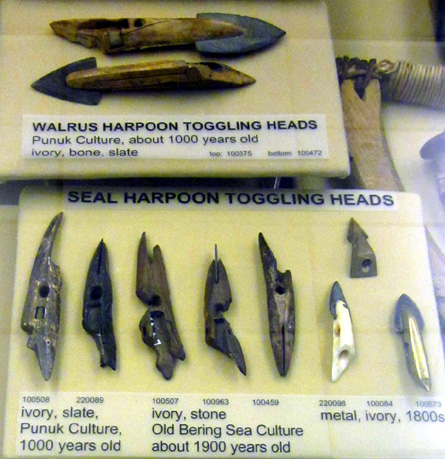
Some very old harpooning tools
It's pretty obvious how important kayaks would have been for survival in
remote Alaskan villages. It was also interesting to learn that a man's kayak was
his most prized possession for some additional reasons. It also helped him
attract a wife, support his family, and accumulate wealth! That makes
sense.
Historically a great deal of ceremony, ritual, and attention to strict
rules went into its construction and boys learned from an early age to
hunt from a kayak using a harpoon or darts to gather food from the
water.
It's a tradition that some Native cultures are trying hard to maintain
in this increasingly technological world.
CLOTHING & ACCESSORIES
I also enjoyed seeing examples of old Native Alaskan garments. Some are
very practical, some beautifully decorated, some used during traditional
ceremonies:
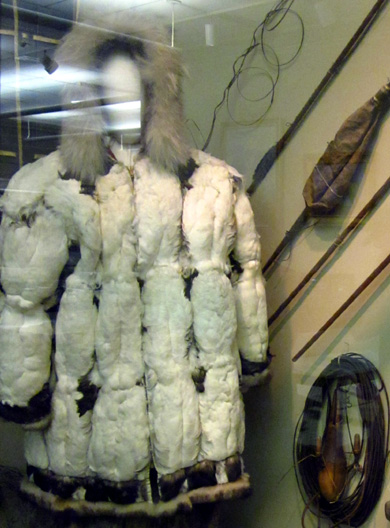
This bird skin parka made in the 1950s is
lightweight,
warm, waterproof, and more durable than it looks.
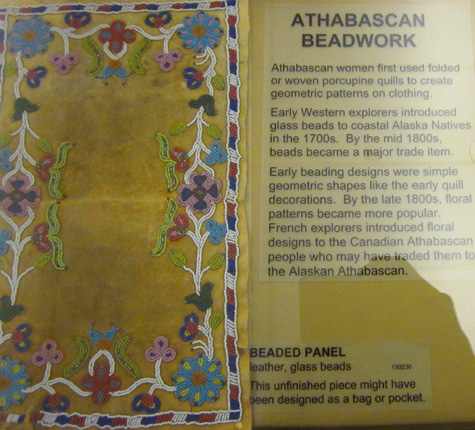
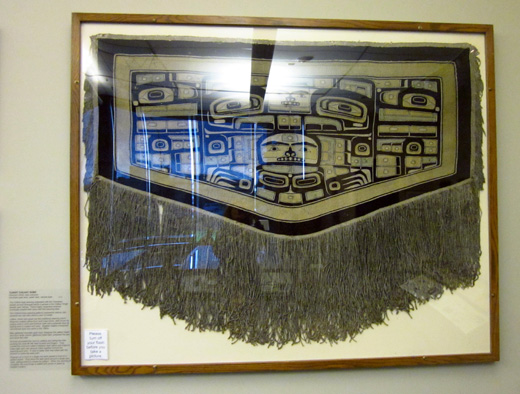
Ceremonial robe
The next photo shows a Tlingit (pronounced KLINK-it) shaman's dancing
apron from the mid-1800s and a set of metal charms above it:
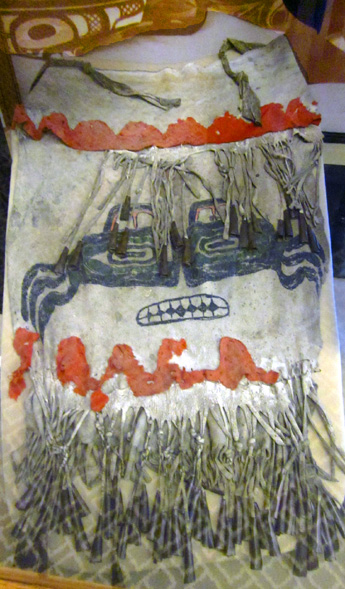
Per the interpretive information provided nearby, "Shamans often wore
special decorated clothing during spiritual rituals. The designs might
protect the shaman or represent a spirit helper. The rhythmic beat of
the metal gun cartridge charms bumping against one another might summon
the shaman's spiritual assistants."
GOLD MINING HISTORY
A smaller section of
the museum features Alaska's mining history, something Wells Fargo was
involved in.
One of the items on display is a 46-ounce
gold nugget found near Ruby, AK in 1963 by Albert Kangas in some discarded gravel
at the mine he co-owned with Asher Richardson. The woman in the picture
is Asher's wife:
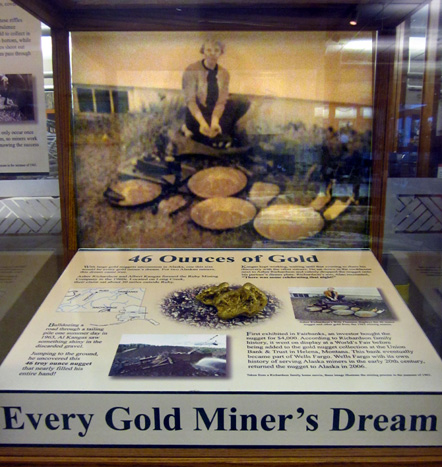
An investor bought
the large nugget for $4,000. After it went on display at the World's
Fair it was added to the gold nugget collection at a bank in Montana
that later merged with Wells Fargo.
Wells Fargo had its
own history serving miners during the Gold Rush in the early 1900s. I
don't have a picture of it but there is a two-thirds scale Wells Fargo
stagecoach from the Alaskan Gold Rush era on display at this museum.
Wells Fargo returned
the nugget to Alaska in 2006 and you can now ogle it here. It's worth a
lot more than $4,000 now . . .
GRACIOUS CURATOR
I suppose it's one of
the duties of the museum's affable curator to keep an eye on that
nugget.
The curator, Tom, is very knowledgeable about this private collection.
When we first got there he was talking with two other couples (below) who
arrived before us, giving us time to browse the exhibits on our own:
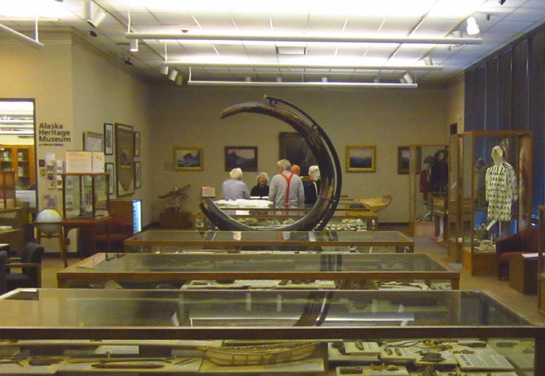
When the other couples left Tom gave us his full attention for about 30
minutes, answering all of our questions and providing additional historical
information that was very interesting to us.
For example, he spent
some time telling us about the antique and newer Russian samovars on his desk:
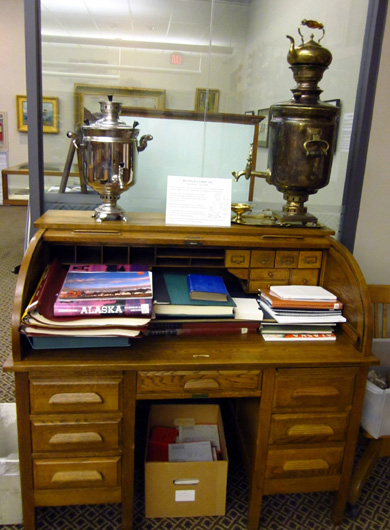
Samovars are large metal containers used to heat
water, usually for tea.
We thoroughly enjoyed this museum and highly recommend
visiting it. Parking and admission are
free. The museum is on the first floor of the Wells Fargo building and
is open on weekday afternoons.
We were surprised to learn that Wells Fargo has ten other
historical/cultural museums
around the country in Charlotte, Los Angeles, Minneapolis, Mobile,
Philadelphia, Phoenix, Portland, Sacramento, San Diego, and San
Francisco. I've been in every one of those cities in the last three
decades but had no clue about the Wells Fargo museums. You can find information about those
locations at the links above.
Whew! We did a lot today. Unless it's poring down rain tomorrow
we plan to ride our bikes on the popular
Tony Knowles Coastal Trail, a paved multi-use path along
Anchorage's waterfront.
Happy trails,
Sue
"Runtrails & Company" - Sue Norwood, Jim O'Neil,
and Cody the ultra Lab
Previous
Next
© 2012 Sue Norwood and Jim O'Neil





















